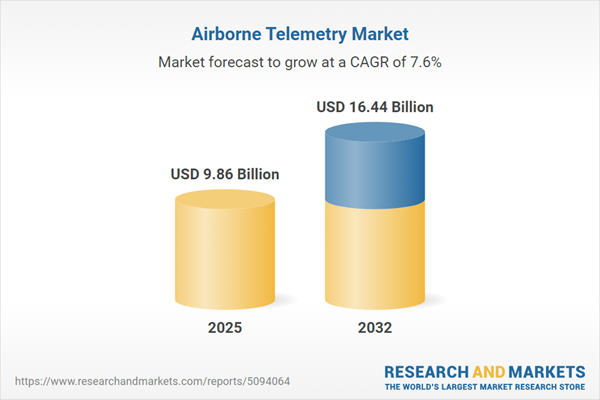Speak directly to the analyst to clarify any post sales queries you may have.
Airborne telemetry enables organizations to achieve real-time oversight, secure data transmission, and adaptive management across aviation operations, supporting the move toward digital transformation and stronger compliance frameworks. As a foundational technology, it underpins efficiency and operational responsiveness for complex, globally distributed fleets.
Market Snapshot: Airborne Telemetry Market Size & Growth Outlook
The airborne telemetry market is experiencing stable expansion aligned with ongoing digitization initiatives in aviation. Projections set the global airborne telemetry market value at USD 9.15 billion in 2024, rising to USD 9.86 billion in 2025, with a compound annual growth rate (CAGR) of 7.60%. Market growth is sustained through investments from civil and defense stakeholders seeking platforms that enhance mission-critical communications and data reliability. New platforms address the imperative of integrated operations, while advancements in communications and data system architectures strengthen resilience and scalability for a wide range of commercial and military aviation needs.
Scope & Segmentation of the Airborne Telemetry Market
This research delivers strategic intelligence for procurement, technology, and compliance leaders evaluating airborne telemetry solutions. Comprehensive segmentation enables targeted decision-making and risk management in line with shifting operational demands:
- Application Areas: Telemetry solutions enable operational requirements such as reconnaissance, surveillance, meteorological monitoring, remote sensing, research, and pilot training, supporting compliance and mission objectives across defense and civilian environments.
- Component Types: The market features critical hardware elements including sensors, transmitters, receivers, antennas, and modular data units, all strengthened by tailored software for real-time management and efficiency.
- Frequency Bands: Coverage spans C-Band, Ka-Band, Ku-Band, L-Band, and S-Band frequencies, maximizing operational flexibility and maintaining alignment with regulatory mandates for global and regional operations.
- Platform Categories: Solutions are engineered for both manned and unmanned aircraft, supporting fixed-wing, rotary-wing, and UAV platforms, and are adaptable for rapid mission-specific deployment and maintenance.
- Regional Coverage: Strategic insights are provided for the Americas, Europe, Asia-Pacific, and Middle East & Africa, identifying regional workforce strengths, regulatory environments, and adoption trends specific to each area.
- Key Technology Providers: Comparative analysis covers major industry suppliers such as L3Harris Technologies, Raytheon Technologies, BAE Systems, Viavi Solutions, Curtiss-Wright, General Dynamics, Cobham, Safran Group, Leonardo, and Honeywell International, enabling more informed sourcing and partnership strategies.
Key Takeaways for Senior Decision-Makers
- Adopting modern airborne telemetry platforms facilitates secure, reliable data exchange and helps ensure continuous compliance across multiple aviation assets.
- Hardware modularity and versatile antenna systems allow for easier integration, scalability, and simplified maintenance within evolving aviation environments.
- The integration of unmanned systems and growing automation are driving demand for smaller, higher-performance telemetry, supporting operational consistency and future-ready autonomy.
- Stronger collaboration between aircraft manufacturers, software companies, and satellite service providers is improving end-to-end system integration and network interoperability across the aviation value chain.
- Organizations must respond to global regulatory shifts by updating procurement and risk management approaches, keeping operations agile and continuous in a complex trade environment.
Tariff Impact: Navigating U.S. Trade and Procurement Dynamics
Current U.S. trade and tariff policies on electronic components have created pressure on aerospace and defense procurement strategies. Organizations are responding by prioritizing nearshoring opportunities and partnering with tariff-exempt suppliers, which aids in cost control and regulatory compliance. At the same time, digital procurement platforms are enhancing transparency and adaptability, allowing businesses to manage changing trade dynamics more effectively.
Methodology & Data Sources
This analysis combines in-depth secondary research, detailed patent reviews, and direct engagement with defense agencies, integrators, and major aerospace contractors. Shipment tracking and benchmarking are included to authenticate findings and ensure the delivery of actionable, dependable market intelligence.
Why This Report Matters
- Supports senior leaders in evaluating airborne telemetry initiatives using detailed segmentation, helping optimize both technology investments and compliance practices.
- Provides actionable regional and application-specific insights, enabling more confident market entry planning and channel development.
- Supplies continuous updates on supplier activity and technology trends, helping organizations remain adaptable to new regulatory requirements and ongoing market evolution.
Conclusion
This report equips procurement and compliance executives to strengthen aviation operations, build resilience, and address emerging challenges as the airborne telemetry landscape evolves.
Additional Product Information:
- Purchase of this report includes 1 year online access with quarterly updates.
- This report can be updated on request. Please contact our Customer Experience team using the Ask a Question widget on our website.
Table of Contents
3. Executive Summary
4. Market Overview
7. Cumulative Impact of Artificial Intelligence 2025
Companies Mentioned
The companies profiled in this Airborne Telemetry market report include:- L3Harris Technologies, Inc.
- Raytheon Technologies Corporation
- Curtiss-Wright Corporation
- Viavi Solutions Inc.
- BAE Systems plc
- General Dynamics Corporation
- Cobham PLC
- Safran Group
- Leonardo S.p.A.
- Honeywell International LLC
Table Information
| Report Attribute | Details |
|---|---|
| No. of Pages | 197 |
| Published | October 2025 |
| Forecast Period | 2025 - 2032 |
| Estimated Market Value ( USD | $ 9.86 Billion |
| Forecasted Market Value ( USD | $ 16.44 Billion |
| Compound Annual Growth Rate | 7.6% |
| Regions Covered | Global |
| No. of Companies Mentioned | 11 |









